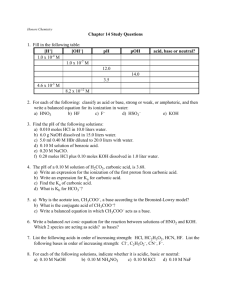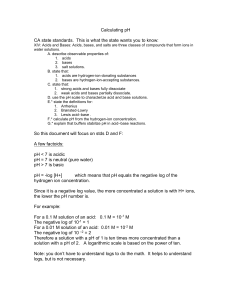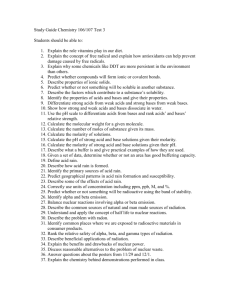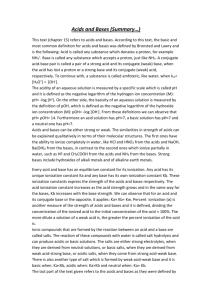Acids and Bases notes
advertisement
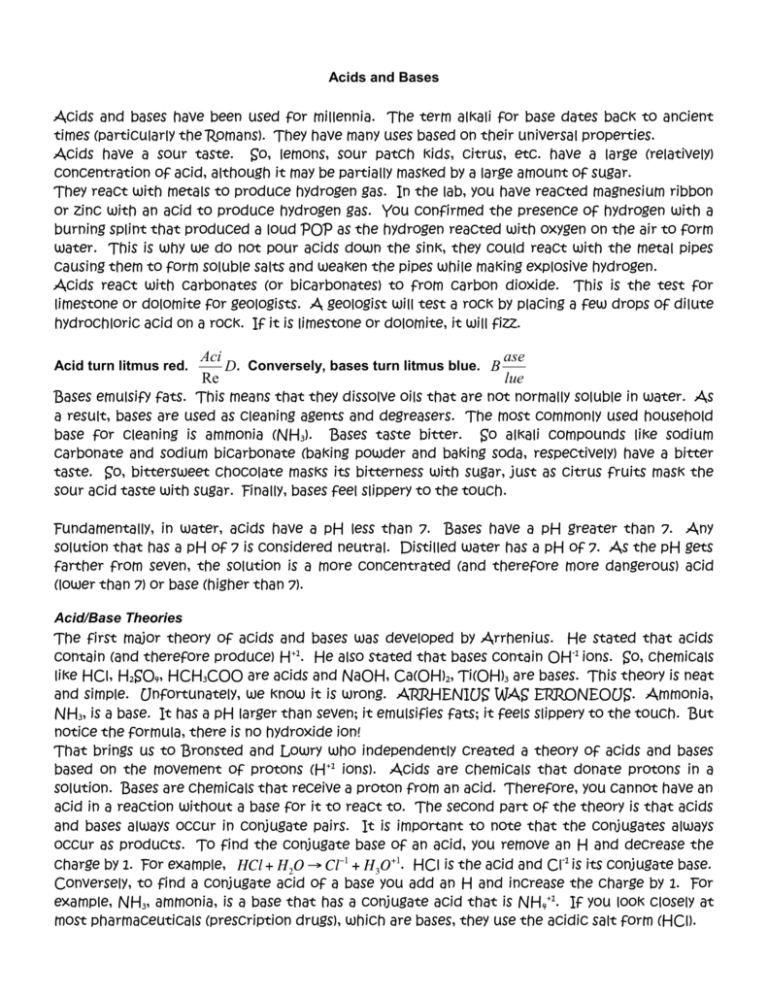
Acids and Bases Acids and bases have been used for millennia. The term alkali for base dates back to ancient times (particularly the Romans). They have many uses based on their universal properties. Acids have a sour taste. So, lemons, sour patch kids, citrus, etc. have a large (relatively) concentration of acid, although it may be partially masked by a large amount of sugar. They react with metals to produce hydrogen gas. In the lab, you have reacted magnesium ribbon or zinc with an acid to produce hydrogen gas. You confirmed the presence of hydrogen with a burning splint that produced a loud POP as the hydrogen reacted with oxygen on the air to form water. This is why we do not pour acids down the sink, they could react with the metal pipes causing them to form soluble salts and weaken the pipes while making explosive hydrogen. Acids react with carbonates (or bicarbonates) to from carbon dioxide. This is the test for limestone or dolomite for geologists. A geologist will test a rock by placing a few drops of dilute hydrochloric acid on a rock. If it is limestone or dolomite, it will fizz. Acid turn litmus red. Aci ase D. Conversely, bases turn litmus blue. B Re lue Bases emulsify fats. This means that they dissolve oils that are not normally soluble in water. As a result, bases are used as cleaning agents and degreasers. The most commonly used household base for cleaning is ammonia (NH3). Bases taste bitter. So alkali compounds like sodium carbonate and sodium bicarbonate (baking powder and baking soda, respectively) have a bitter taste. So, bittersweet chocolate masks its bitterness with sugar, just as citrus fruits mask the sour acid taste with sugar. Finally, bases feel slippery to the touch. Fundamentally, in water, acids have a pH less than 7. Bases have a pH greater than 7. Any solution that has a pH of 7 is considered neutral. Distilled water has a pH of 7. As the pH gets farther from seven, the solution is a more concentrated (and therefore more dangerous) acid (lower than 7) or base (higher than 7). Acid/Base Theories The first major theory of acids and bases was developed by Arrhenius. He stated that acids contain (and therefore produce) H+1. He also stated that bases contain OH-1 ions. So, chemicals like HCl, H2SO4, HCH3COO are acids and NaOH, Ca(OH)2, Ti(OH)3 are bases. This theory is neat and simple. Unfortunately, we know it is wrong. ARRHENIUS WAS ERRONEOUS. Ammonia, NH3, is a base. It has a pH larger than seven; it emulsifies fats; it feels slippery to the touch. But notice the formula, there is no hydroxide ion! That brings us to Bronsted and Lowry who independently created a theory of acids and bases based on the movement of protons (H+1 ions). Acids are chemicals that donate protons in a solution. Bases are chemicals that receive a proton from an acid. Therefore, you cannot have an acid in a reaction without a base for it to react to. The second part of the theory is that acids and bases always occur in conjugate pairs. It is important to note that the conjugates always occur as products. To find the conjugate base of an acid, you remove an H and decrease the charge by 1. For example, . HCl is the acid and Cl-1 is its conjugate base. Conversely, to find a conjugate acid of a base you add an H and increase the charge by 1. For example, NH3, ammonia, is a base that has a conjugate acid that is NH 4+1. If you look closely at most pharmaceuticals (prescription drugs), which are bases, they use the acidic salt form (HCl). Another piece of Bronsted-Lowry theory is that a weak acid has a strong conjugate base and vice versa. The smaller the Ka value is the weaker the acid. So, acids that have very small K a have conjugate bases that have a large value for Kb. Bronsted and Lowry also defined some substances as amphoteric. This refers to chemicals that can act as either an acid or a base depending on what you react the chemical with. For example, if you put an acid such as HCl or HCH3COO in water, water will behave as a base and accept a proton from the acid to form H3O+1, hydronium ion, as a conjugate acid. On the other hand, if you put a base in water, then it will behave as an acid by donating a proton (H+1) to the base. There is a fundamental problem with the Bronsted-Lowry theory. Protons are not transferred in a chemical reaction! If a proton were transferred from one atom to another, the identities of the atoms would change. Simply put, we would be performing ALCHEMY not CHEMISTRY. This flaw was accounted for by Lewis (yes, the electron dot guy). Lewis stated that acids are electron receivers (or electron poor, which means positive). Bases would therefore be electron donors (i.e. electron rich or negatively charged). Fundamentally, this means that nearly every chemical reaction can be defined as an acid-base reaction. It also means that every time you have a central atom with a lone pair it can act as a base. It also means that any atom that is the positive end of a polar bond (or a metal cation) can act as an acid. This explains such things as protein synthesis, digestion, etc. Unfortunately, Lewis theory cannot be used to calculate the molarity of H+1, [H+1], or pH. The Math of Acids and Bases Chemists would like to describe the acidity of a solution with the molarity of the H +1 or H3O+1 ion. However, these numbers are usually extremely small from 1.0 E-3 (.001) M to 1.0 E-11 (0.00000000001). Therefore, to make the numbers more manageable, chemists use a logarithmic scale called pH which stands for the ‘power of the Hydronium ion.’ pH = -log[H +1] [ For a base, it is more convenient to measure the [OH-1] and use pOH. pOH = -log OH The two are easily interchanged using the equation pH + pOH =14 The key is knowing how to find the [H+1] or [OH-1] to start. -1 ] A. STRONG ACID For any of the strong acids (HCl, HBr, HI, HNO3,HClO4,HClO3, and H2SO4), the [H+1] is equal to the molarity of the acid. This flows from the definition of a strong acid. Strong acids ionize completely in water so the concentration of the hydronium ion, as well as the concentration of the conjugate base, are equal to the molarity of the acid. B. WEAK ACID For any weak acid, it only partially ionizes in water. Consequently, the molarity of the hydronium ion is always less than the original molarity of the acid. 1. Given percent ionization: [H+1]=M*%ionization You must remember to change the percentage ionization to a decimal by dividing by 100. For example, if you had a 0.25 M weak acid that ionizes at 3.2%, [H ] = .25 * .032 = .008M +1 2. Given a Ka value The acid equilibrium constant, Ka, is more widely used than percent ionization. Ka = x2 M The ‘x’ is the [H+1]. The ‘M’ is the original molarity of the acid. For example, a 0.125 M solution of acetic acid has a Ka value of 1.8 E-5. x2 .125 .125(1.8E - 5) = x 2 = 2.25E - 6 1.8E - 5 = 2.25E - 6 = x 2 0.0015 M = x C.STRONG BASE The strong bases are the only hydroxides that were soluble according to the rules we learned for double replacement. Column 1 hydroxides and Calcium, Barium, and Strontium (bottom of column 2) are completely soluble and are strong bases. For the column 1 hydroxides, the [OH-1] equals the molarity of the base. For barium, strontium, and calcium hydroxides the [OH-1] is equal to twice the molarity of the base. D. WEAK BASE For any weak base, it only partially ionizes in water. Consequently, the molarity of the hydroxide ion is always less than the original molarity of the base. 1. Given percent ionization: [OH-1]=M*%ionization You must remember to change the percentage ionization to a decimal by dividing by 100. 2. Given a KB value The base equilibrium constant, KB, is more widely used than percent ionization. Ka = x2 M The ‘x’ is the [OH-1]. The ‘M’ is the original molarity of the base. Notice, that weak acids and bases use the same formulae; however, the unknown ‘x’ represents something different (x is the [H+1] for acids and [OH-1] for bases). The math is identical and lends itself to easy calculator manipulations. HOW TO FIND pH, pOH, [H+1], and [OH-1] These four things are all related, so if you know one of them you can find the other three using the set of equations. pH = - log[H+] pOH = - log[OH-] pH + pOH = 14 Where you start depends on what you know. For example, you have 0.0035 M HCl. You KNOW the [H+]. So, the only place you can start is with the top equation. pH = -log[H+] = -log [.0035] = 2.46 Now you know pH as well, so that allows you to drop to the bottom equation. pH +pOH = 14 2.46 + pOH =14 So, pOH =11.54. The only equation left is the middle one. pOH = - log[OH-] 11.54 = - log [OH-] To solve for something inside the log, you MUST use the inverse log function, (commonly referred to as the ANTILOG). But, first, you must get all the numbers, including the negative one on the right, to one side and the log function by itself on the other. So, simply stated, just reverse the sign of both sides. -11.54 = +log[OH-] Now take the antilog of both sides. ANTILOG(-11.54) = ANTILOG(log[OH ]) Log and antilog annihilate each other. Antilog on your calculator is just [2nd] [log]. So hit [2nd][log](-11.54) [enter] 2.86E-12 M = [OH-]





